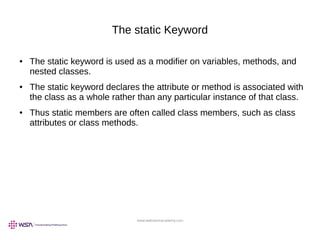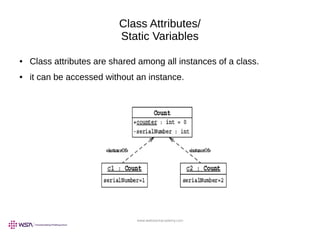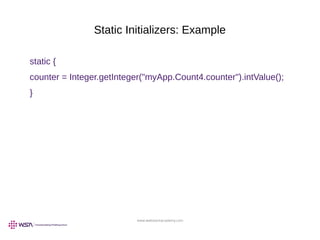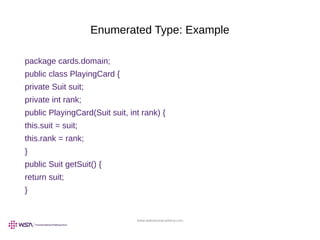Core Java Programming Language (JSE) : Chapter VII - Advanced Class Features
- 1. www.webstackacademy.com Java Programming Language SE – 6 Module 7 : Advanced Class Features
- 2. www.webstackacademy.com Objectives ● Create static variables, methods, and initializers ● Create final classes, methods, and variables ● Create and use enumerated types ● Use the static import statement ● Create abstract classes and methods ● Create and use an interface
- 3. www.webstackacademy.com Relevance ● How can you create a constant? ● How can you declare data that is shared by all instances of a given class? ● How can you keep a class or method from being subclassed or overridden?
- 4. www.webstackacademy.com The static Keyword ● The static keyword is used as a modifier on variables, methods, and nested classes. ● The static keyword declares the attribute or method is associated with the class as a whole rather than any particular instance of that class. ● Thus static members are often called class members, such as class attributes or class methods.
- 5. www.webstackacademy.com Class Attributes/ Static Variables ● Class attributes are shared among all instances of a class. ● it can be accessed without an instance.
- 6. www.webstackacademy.com Class Methods/ Static Methods public static int getTotalCount() { return counter; } ● You can invoke static methods without any instance of the class to which it belongs. ● Static methods cannot access instance variables.
- 7. www.webstackacademy.com Static Initializers ● A class can contain code in a static block that does not exist within a method body. ● Static block code executes once only, when the class is loaded. ● Usually, a static block is used to initialize static (class) attributes.
- 8. www.webstackacademy.com Static Initializers: Example static { counter = Integer.getInteger("myApp.Count4.counter").intValue(); }
- 9. www.webstackacademy.com The final Keyword ● You cannot subclass a final class. ● You cannot override a final method. ● A final variable is a constant. ● You can set a final variable once only, but that assignment can occur independently of the declaration; this is called a blank final variable. ● A blank final instance attribute must be set in every constructor. ● A blank final method variable must be set in the method body before being used.
- 10. www.webstackacademy.com Final Variables Constants are static final variables. public class Bank { private static final double ... // more declarations }
- 11. www.webstackacademy.com Blank Final Variables private final long customerID; public Customer() { customerID = createID(); }
- 12. www.webstackacademy.com Enumerated Type package cards.domain; public enum Suit { SPADES, HEARTS, CLUBS, DIAMONDS }
- 13. www.webstackacademy.com Enumerated Type: Example package cards.domain; public class PlayingCard { private Suit suit; private int rank; public PlayingCard(Suit suit, int rank) { this.suit = suit; this.rank = rank; } public Suit getSuit() { return suit; }
- 14. www.webstackacademy.com Enumerated Type public String getSuitName() { String name = ““; switch ( suit ) { case SPADES: name = “Spades”; break; case HEARTS: name = “Hearts”; break; case CLUBS: name = “Clubs”; break; case DIAMONDS: name = “Diamonds”; break; default: }return name;}
- 15. www.webstackacademy.com Enumerated Type ● Enumerated types are type-safe: package cards.tests; import cards.domain.PlayingCard; import cards.domain.Suit; public class TestPlayingCard { public static void main(String[] args) { PlayingCard card1 = new PlayingCard(Suit.SPADES, 2); System.out.println(“card1 is the “ + card1.getRank() + “ of “ + card1.getSuitName()); // PlayingCard card2 = new PlayingCard(47, 2); // This will not compile. }}
- 16. www.webstackacademy.com Advanced Enumerated Types ● Enumerated types can have attributes and methods: package cards.domain; public enum Suit { SPADES (“Spades”), HEARTS (“Hearts”), CLUBS (“Clubs”), DIAMONDS (“Diamonds”); private final String name; private Suit(String name) { this.name = name; } public String getName() { return name;}}
- 17. www.webstackacademy.com Advanced Enumerated Types package cards.tests; import cards.domain.PlayingCard; import cards.domain.Suit; public class TestPlayingCard { public static void main(String[] args) { PlayingCard card1 = new PlayingCard(Suit.SPADES, 2); System.out.println(“card1 is the “ + card1.getRank() + “ of “ + card1.getSuit().getName()); // NewPlayingCard card2 = new NewPlayingCard(47, 2); // This will not compile. }}
- 18. www.webstackacademy.com Static Imports ● A static import imports the static members from a class: import static <pkg_list>.<class_name>.<member_name>; OR import static <pkg_list>.<class_name>.*; ● A static import imports members individually or collectively: import static cards.domain.Suit.SPADES; OR import static cards.domain.Suit.*;
- 19. www.webstackacademy.com Abstract Classes public class FuelNeedsReport { private Company company; public FuelNeedsReport(Company company) { this.company = company; } public void generateText(PrintStream output) { Vehicle1 v; double fuel; double total_fuel = 0.0; for ( int i = 0; i < company.getFleetSize(); i++ ) { v = company.getVehicle(i);
- 20. www.webstackacademy.com Abstract Classes // Calculate the fuel needed for this trip fuel = v.calcTripDistance() / v.calcFuelEfficency(); output.println("Vehicle " + v.getName() + " needs " + fuel + " liters of fuel."); total_fuel += fuel; } output.println("Total fuel needs is " + total_fuel + " liters."); }}
- 21. www.webstackacademy.com Abstract Classes ● An abstract class models a class of objects in which the full implementation is not known but is supplied by the concrete subclasses.
- 22. www.webstackacademy.com Interfaces ● A public interface is a contract between client code and the class that implements that interface. ● A Java interface is a formal declaration of such a contract in which all methods contain no implementation. ● Many unrelated classes can implement the same interface. ● A class can implement many unrelated interfaces. ● Syntax of a Java class is as follows: <modifier> class <name> [extends <superclass>] [implements <interface> [,<interface>]* ] { <member_declaration>* }
- 23. www.webstackacademy.com Uses of Interfaces Interface uses include the following: ● Declaring methods that one or more classes are expected to implement ● Determining an object’s programming interface without revealing the actual body of the class ● Capturing similarities between unrelated classes without forcing a class relationship ● Simulating multiple inheritance by declaring a class that implements several interfaces
- 24. Web Stack Academy (P) Ltd #83, Farah Towers, 1st floor,MG Road, Bangalore – 560001 M: +91-80-4128 9576 T: +91-98862 69112 E: [email protected] www.webstackacademy.com















![www.webstackacademy.com
Enumerated Type
● Enumerated types are type-safe:
package cards.tests;
import cards.domain.PlayingCard;
import cards.domain.Suit;
public class TestPlayingCard {
public static void main(String[] args) {
PlayingCard card1 = new PlayingCard(Suit.SPADES, 2);
System.out.println(“card1 is the “ + card1.getRank() + “ of “ +
card1.getSuitName());
// PlayingCard card2 = new PlayingCard(47, 2);
// This will not compile.
}}](https://image.slidesharecdn.com/007javaseadvancedclassdesign-190430061009/85/Core-Java-Programming-Language-JSE-Chapter-VII-Advanced-Class-Features-15-320.jpg)

![www.webstackacademy.com
Advanced Enumerated
Types
package cards.tests;
import cards.domain.PlayingCard;
import cards.domain.Suit;
public class TestPlayingCard {
public static void main(String[] args) {
PlayingCard card1 = new PlayingCard(Suit.SPADES, 2);
System.out.println(“card1 is the “ + card1.getRank()
+ “ of “ + card1.getSuit().getName());
// NewPlayingCard card2 = new NewPlayingCard(47, 2);
// This will not compile.
}}](https://image.slidesharecdn.com/007javaseadvancedclassdesign-190430061009/85/Core-Java-Programming-Language-JSE-Chapter-VII-Advanced-Class-Features-17-320.jpg)




![www.webstackacademy.com
Interfaces
● A public interface is a contract between client code and the class that
implements that interface.
● A Java interface is a formal declaration of such a contract in which all
methods contain no implementation.
● Many unrelated classes can implement the same interface.
● A class can implement many unrelated interfaces.
● Syntax of a Java class is as follows:
<modifier> class <name> [extends <superclass>]
[implements <interface> [,<interface>]* ] {
<member_declaration>*
}](https://image.slidesharecdn.com/007javaseadvancedclassdesign-190430061009/85/Core-Java-Programming-Language-JSE-Chapter-VII-Advanced-Class-Features-22-320.jpg)

